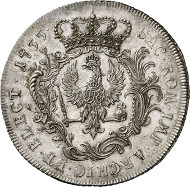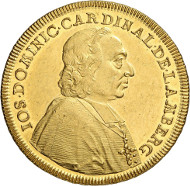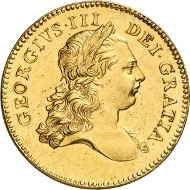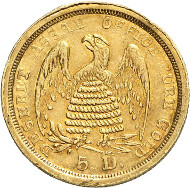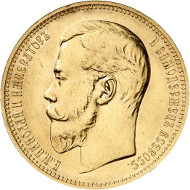28-01-2015 – 01-01-1970
Berlin Auction 2015
The Künker Berlin Sale: One Highlight after the Next
Within the upcoming Berlin sale, to be hold on January 29, 2015, one highlight comes after the next. It starts with 258 spectacular showpieces from the Horn Collection, including a large series of Saxon rarities. Next in line are 238 lots of German coins from different possessions, every item of which is something special, too. The 76 world coins and medals come partly from the Horn Collection featuring a collection of Poland, a series of English guineas and a collection of early American gold dollars. The auction sale ends with 258 Russian coins, the crème de la crème, rarest of the rare. Thus, there is every chance that one or two record prices will be obtained.
Lot 34: HORN COLLECTION – PRUSSIA. Frederick II. Speciesthaler 1755, without mintmark, Berlin. Kluge 318. Extremely rare. First strike, about brilliant uncirculated. Estimate: 40,000,- euros.
It is rather difficult to single out individual pieces from this remarkable material, with so many items pushing themselves to the fore. To start with the Horn Collection, the combination of great rarity and magnificent grade has to be emphasized, being the characteristic feature of most items here. Take a case in point, the extremely rare speciesthaler from 1755, which Frederick II, the Great, had minted for trading purposes. Just 16 examples have survived. The one offered for sale is a splendid specimen, a first strike with tiny adjustment marks in about brilliant uncirculated (34, estimate: 40,000 euros).
Lot 41: HORN COLLECTION – BRUNSWICK-WOLFENBÜTTEL. Julius II. Löser of 9 reichsthaler 1574, Heinrichstadt (Wolfenbüttel). Welter 548. Extremely rare. Very fine to extremely fine. Estimate: 50,000,- euros.
The gorgeous löser of 9 reichsthaler of Julius of Brunswick-Wolfenbüttel from 1574 not only is of utmost rarity but is likewise an extraordinarily attractive item due to its beautiful patina and the grade, very fine to extremely fine (41, estimate: 50,000 euros), just like the reichsthaler of Anna Salome of Salm-Reifferscheid, who had as Abbess of Essen this wonderful coin made in 1680. The extremely rare coin comes in about extremely fine and is unusually attractive with its marvelous patina (68, estimate: 20,000 euros).
Lot 183: COLLECTION HORN – SAXONY. Frederick August III (I). Double konventionsthaler 1780, Dresden, reward of diligence. Dav. 2694. Only 20 specimens struck. First strike, brilliant uncirculated. Estimate: 20,000,- euros.
And we have not even reached Saxony, the main collection field of Otto Horn who was living in the city of Meißen. All the “splendid specimens” and “showpieces” included here would make a collection of their own. Just look at the rare double thaler of Frederick August II on the death of his father August the Strong in 1733 with its superb patina and its perfect state of preservation (175, estimate: 10,000 euros) or the double konventionsthaler from 1780 of Frederick August III with a mintage of only 20 specimens, a first strike made with polished dies, that virtually anticipates what modern mints refer to as Proof (183, estimate: 20,000 euros). But there are also fantastic coins with a three-digit estimate. A simple vereinsthaler of John, King of Saxony 1854-1873, a first strike from 1861 with a marvelous patina in brilliant uncirculated is estimated at 500 euros only (192).
Lot 266: GERMANY – BAVARIA. Maximilian I. 8 ducats 1598, Munich, on his homage. Witt. 775 note. Very rare. Extremely fine. Estimate: 50,000,- euros.
We are leaving the Horn Collection, but we are still in Germany and again we are spoilt for choice. There is the Bavarian 8 ducat piece from 1598 on the homage to Maximilian I (266, EF, estimate: 50,000 euros), the pattern of the Bremen 5 mark piece 1904 without border of dots on the side of the coat of arms (331, ab. BU from Proof, estimate: 30,000 euros), the unique philippsgoldgulden of John II, Duke of Cleves, minted in Wesel in 1502 (381, VF, estimate: 30,000 euros) …
Lot 405: GERMANY – PASSAU. Joseph Dominicus of Lamberg. 6 ducats 1753, Vienna, on his jubilee 50 years ordination of priest. Fb. 2073. Very rare. Extremely fine. Estimate: 50,000,- euros.
… the Passau 6 ducat piece of Joseph Dominicus of Lamberg on his jubilee 50 years ordination of priest (405, EF, estimate: 50,000 euros), not to forget the triple ducat of August the Strong of Saxony from 1696 (441, EF-BU, estimate: 35,000 euros), and the probably most beautiful specimen of the Trier konventionsthaler from 1773 (485, BU, estimate: 25,000 euros). And there is much more to come!
Lot 779: GUATEMALA. Federal Republic of Central America. 8 escudos 1824 NG-M, Guatemala. Fb. 62. Graded MS 62 by NGC. Extremely rare. Extremely fine to brilliant uncirculated. Estimate: 60,000,- euros.
Now, we are going abroad, first to the foreign countries in Europe, and then overseas. There, remarkable items can be discovered, too, like a Danish double ducat of Christian V from 1691 (554, EF-BU, estimate: 17,500 euros), the two types of the 100 perpera from Montenegro, struck in 1910 (637 and 638, both EF from Proof, estimate: 20,000 euros each) or a 8 escudos from Guatemala from 1824 in the name of the Federal Republic of Central America (779, EF-BU, estimate: 60,000 euros).
Lot 605: GREAT BRITAIN. Victoria. 5 pounds 1839, London “Una and the Lion”. Fb. 386. Very rare. Tiny traces of working, fine scratches, Proof. Estimate: 40,000,- euros.
This takes us to series and collections worth mentioning. At present, Great Britain is a highly popular collection area, with mainly the heavy gold coins obtaining spiraling prices. This is why things will become exciting with the lots following #577, for there are not only one or two 5 guinea pieces hidden in the material from Great Britain but a considerable number. It all starts with Charles II 1668; next are James II 1688, William III and Mary 1692, William III sole 1701, George I 1726, as well as George II 1729 and 1746. What about the prices? Well, the cheapest piece is being estimated at 5,000 euros.
Lot 600: GREAT BRITAIN. George III. 5 guineas 1773, London. Pattern with plain edge. Extremely rare. Extremely fine. Estimate: 100,000,- euros.
Which is the most expensive one? We have not even mentioned it yet: the extremely rare pattern of a 5 guineas piece 1773 for George III, which was never released, offered in this auction for 100,000 euros.
Lot 665: POLAND – KINGDOM. Sigismund III. 1/2 portugalöser of 5 ducats 1622, Vilnius for Lithuania. Kopicki 3562 (R7). Extremely rare. Extremely fine. Estimate: 80,000,- euros.
Likewise pieces of greatest rarity are available from the Kingdom of Poland, like a half portugalöser of 5 ducats from 1622 (665, EF, estimate: 80,000 euros). Equally as rare, at least, is a double ducat of John Casimir, minted in Fraustadt in 1650 (670, EF, estimate: 60,000 euros). And these were just two items from the vast number of rarities on offer: 23 out of 49 pieces have an estimate in the five-digit region!
Lot 815: USA. Utah. 5 dollars 1860. Issued by the Mormons, Salt Lake City. Fb. 59. Very rare. Very fine to extremely fine. Estimate: 35,000,- euros.
Compared to that, a small series of early gold coins from the United States of America is rather inexpensive, even though it is hard to think of coins that evoke more dreams than these.
You see, the gold 1, 5, 10 and 20 dollar pieces are testimonies to the different kinds of gold rushes: first, the gold rush of North Carolina in 1799 during which the gold was yielded that was used for producing gold dollars only since 1831, second, the gold rush of Georgia in 1828. The most famous ones of course are the coins from California.
200 euros are enough to enter the bidding although the top items, a 10 dollar from 1849, issued by the Miners Bank in San Francisco (803, EF, estimate: 20,000 euros) and a 5 dollar of the Mormons from Salt Lake City from 1860 (815, VF-EF, estimate: 35,000 euros) will certainly obtain completely different prices.
Lot 931: RUSSIA. Nicholas I. 6 roubel platinum 1834, St. Petersburg. Bitkin 60 (R3). Only 11 specimens struck. With expertise of Igor Shiryakov, State Historical Museum Moscow. Proof. Estimate: 100,000,- euros.
If that weren’t enough, the Russian section begins with a whole series of rarities, too. Capitulating considering the sheer mass of big hits, we restrict ourselves merely to the pieces with a pre-sale estimate of 50,000 euros plus, which still are six lots: 100,000 euros is the estimate of a platinum 6 roubel piece made, of which only 11 pieces had been made in St. Petersburg in 1834 (931).
Lot 1055: RUSSIA. Nicholas II. 37 1/2 roubel (100 francs) 1902, St. Petersburg. Bitkin 315 (R2). Only 225 specimens struck. With expertise of Igor Shiryakov, State Historical Museum Moscow. Extremely fine. Estimate: 75,000,- euros.
A 37 ½ roubel piece, equivalent of 100 francs, from 1902 is estimated at 75,000 euros (1055). The mintage of the latter was 225 examples. 60,000 euros are expected for a 10 roubel piece of Peter III from 1762 (873). Three lots are estimated at 50,000 euros: a 50 zlotych 1823 for Poland of which only 181 specimens were minted (917), the same denomination from 1827, with a mintage of 299 specimens (967) and a gold prize medal of the Tsar Nicholas Lyceum in Moscow that was awarded to graduates of the secondary classes at the beginning of the 19th century (1065).
1,078 lots with a total estimate adding up to 6.5 million – these numbers really outline the auction sale. But only a careful examination of the catalog reveals the numerous interesting stories these coins and medals are telling. At the end of the day, a coin dealer does not just sell a piece of metal but the story it is linked to.
The catalogs may be ordered at Künker, Nobbenburgerstr. 4a, D-49 076 Osnabrück; phone +49 (0)541 / 96 20 20; telefax: +49 (0)541 / 96 20 222; or by writing an email. All coins can be viewed online on Künker’s website.
Additionally you will find all information regarding this auction on the Künker website.





